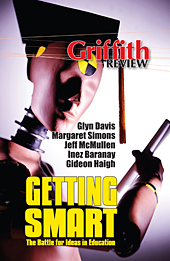Featured in

- Published 20060307
- ISBN: 9780733316210
- Extent: 268 pp
- Paperback (234 x 153mm)

Already a subscriber? Sign in here
If you are an educator or student wishing to access content for study purposes please contact us at griffithreview@griffith.edu.au
Share article
More from author

The juror’s tale
ReportageON A STEAMY Sydney day, I find myself in a crowded room, summoned for jury service. There are about fifty of us, all called...
More from this edition

Encounters with Mrs L BA(OXON)
MemoirAbout suffering they were never wrong,The Old Masters; how well, they understoodIts human position....– WH AudenABOUT GLAMOUR THEY were also never wrong, the Old...

Hamlet in a classroom
EssayIN MY TEENS I revered writers. I hung onto their words the way my classmates hung onto marijuana. I believed writers had the gift...

Flying the flag for mainstream Australia
EssayON JUNE 2004, the Prime Minister, John Howard, and the former Federal Minister for Education, Brendan Nelson, announced a new $31 billion federal education...